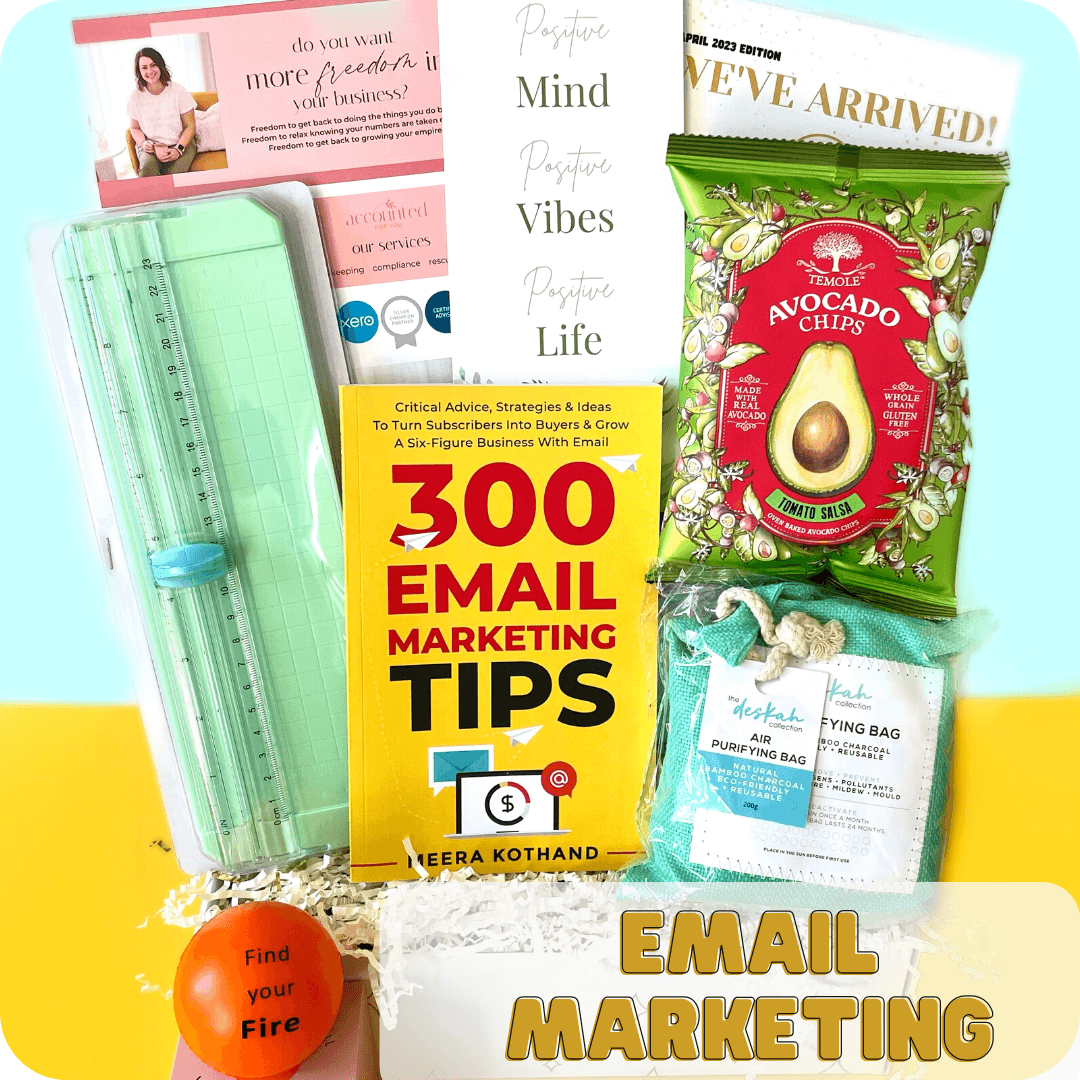Are You Guilty of These 4 Email Marketing Mistakes? Here’s what they are & how to fix them
Ladies, listen up! As a small business owner, you know that email marketing is an essential part of your business. But let's face it, email marketing can be overwhelming and downright confusing at times. That's why we're here to help you with four lessons from Meera Kothand's "300 Email Marketing Tips" that will not only help you succeed but also make you feel confident in your email marketing efforts.
Mistake # 1: Too Long - INSTEAD Keep it Short & Sweet
We know you're busy running your business, and so are your subscribers! They don't have time to read a novel-length email from you.
That's why Meera suggests keeping your emails to around 200 words. But don't worry, you can still pack a punch in those 200 words.
Use headings, subheadings, and bullet points to make your message easy to read and digest.
For example, let's say you run a boutique clothing store. You could send an email to your subscribers with the subject line "5 Spring Fashion Trends You Need to Know About." In the email, use bullet points to list the five trends, and include an eye-catching photo of each trend. This approach is not only concise but also visually appealing, making it more likely that your subscribers will engage with your email.
Here are some general guidelines for ideal email length based on industry:
Retail: 50-125 words
E-commerce: 50-125 words
Non-profit: 50-150 words
Healthcare: 50-200 words
B2B: 125-200 words
Financial services: 125-200 words
Education: 150-300 words
Travel and hospitality: 150-300 words
However, it's important to keep in mind that these are just general guidelines and may vary based on your specific audience and content. It's always a good idea to test different email lengths to see what works best for your subscribers.
Mistake #2: You email everyone the same thing, INSTEAD Segment Your List
Source: TechTarget
Not all subscribers are created equal, and that's where segmentation comes in. By dividing your email list into groups based on factors like past purchases or interests, you can tailor your messages to be more relevant to each group. This leads to higher engagement and conversion rates.
For instance, let's say you run a health and wellness blog. You could segment your list into two groups: one group for subscribers who are interested in yoga and another group for those interested in nutrition. By doing this, you can send targeted emails to each group with content that is specific to their interests. Your yoga group would receive emails with yoga-related tips, while your nutrition group would receive emails with recipes and healthy eating tips.
More Examples of how else you can segment your list
Demographics: Age, gender, location, income, job title, etc.
Behavior: Past purchases, website activity, email opens/clicks, etc.
Interests: Product/service preferences, content consumed, sign-up form selections, etc.
Engagement: Frequency of interaction with your brand, social media activity, etc.
Stage of the buyer’s journey: Awareness, consideration, decision-making, etc.
Inactive subscribers: Subscribers who haven’t engaged with your emails in a while.
New subscribers: Subscribers who recently joined your email list.
VIP customers: High-value customers who make frequent purchases or spend a lot of money.
Geographic location: Subscribers who live in a specific region or country.
Preferences: Email frequency, content type, preferred channels of communication, etc.
By segmenting your email list, you can tailor your messages to be more relevant and personalized, leading to higher engagement and conversion rates.
Mistake #3: No Purpose to the Email, INSTEAD Provide Value in Every Email
Your subscribers receive hundreds of emails a day, and they won't hesitate to hit that "unsubscribe" button if they don't see any value in your emails. That's why it's crucial to provide value in every email you send.
Share helpful tips, exclusive discounts, or even a personal story that your subscribers can relate to. By consistently providing value, you can build trust with your subscribers and keep them engaged with your brand.
For example, let's say you're a life coach. You could send an email to your subscribers with the subject line "How to Beat Procrastination Once and for All." In the email, share three practical tips that your subscribers can implement immediately. This approach not only provides value but also positions you as an expert in your field.
MORE EXAMPLES OF VALUE-ADDING EMAILS BASED ON INDUSTRY
E-commerce Store
Exclusive discounts for email subscribers.
Personalised recommendations based on previous purchases.
Early access to new product launches.
Behind-the-scenes look at the production process or the team behind the brand.
Service-Based Business (e.g. Consulting, Coaching)
Free resources such as e-books or worksheets.
Industry insights and trends.
Invitations to webinars or events.
Case studies or success stories from previous clients.
Health and Wellness (e.g. Gym, Yoga Studio, Nutritionist)
At-home workout plans or healthy recipes.
Wellness tips and tricks.
Invitations to free classes or events.
Educational content about the benefits of a healthy lifestyle.
Finance (e.g. Accounting, Investment)
Expert advice and insights about the current financial landscape.
Tips on how to save money or invest wisely.
Educational content about financial planning.
Free consultations or financial assessments.
Travel and Hospitality (e.g. Hotel, Tour Operator)
Exclusive travel deals and promotions.
Destination guides and travel tips.
Behind-the-scenes look at the hospitality industry.
Personalised recommendations based on travel history or interests.
Mistake #4: You have no idea what’s actually working, INSTEAD Test and Iterate Your Campaigns
There's no one-size-fits-all approach to email marketing, and that's why it's essential to test and iterate your campaigns. Experiment with different subject lines, calls to action, and other elements to see what resonates best with your subscribers. By continually analysing your results and making adjustments, you can optimise your campaigns over time and achieve better results.
For instance, let's say you run an online store that sells eco-friendly products. You could send two different versions of an email with different subject lines. Version A could have the subject line "New Eco-Friendly Products Just In!" while Version B could have the subject line "Shop Responsibly with Our New Eco-Friendly Products." After analysing the results, you may find that Version B has a higher open rate, indicating that your subscribers respond better to messaging that emphasises sustainability.
Here are some examples of tests you could run and recommended testing time frames:
Subject line testing: This involves testing two different subject lines to see which one results in higher open rates. A good testing time frame is about 1-2 weeks.
Call-to-action testing: This involves testing different calls-to-action (CTAs) within your email to see which one results in higher click-through rates. A good testing time frame is about 1-2 weeks.
Timing testing: This involves testing different days and times to send your emails to see which time results in higher open and click-through rates. A good testing time frame is about 1 month.
Content testing: This involves testing different content within your emails to see which type of content (e.g. tips, product features, promotions) resonates best with your audience. A good testing time frame is about 1-2 months.
It's important to note that the length of time needed for testing can vary depending on the size of your email list and the frequency of your email sends. The key is to give yourself enough time to gather sufficient data and make informed decisions based on the results.
FOR THE SKIMMERS - READ THIS AT LEAST
If you're feeling overwhelmed by email marketing, don't worry! Meera Kothand's book, "300 Email Marketing Tips," has got your back. Here are the key takeaways:
Keep it short and sweet: Nobody has time to read a novel-length email. Keep it to around 200 words, use headings and bullet points, and include eye-catching visuals.
Segment your list: Divide your email list into groups based on factors like past purchases or interests, and tailor your messages to be more relevant to each group.
Provide value in every email: Share helpful tips, exclusive discounts, or personal stories that your subscribers can relate to. Build trust with your subscribers and keep them engaged.
Test and iterate your campaigns: There's no one-size-fits-all approach to email marketing, so experiment with different elements and analyze the results to optimize your campaigns.
By following these tips, you can build a successful email marketing program that drives engagement, conversions, and revenue for your business.
Enjoyed this blog? Be sure to share this with your fellow entrepreneurs!
BEFORE YOU GO, DID YOU KNOW…
For example books like 300 Email Marketing Tips!? This is in our April 2023 Aussie Biz Chic Box. A entrepreneur subscription box dedicated to helping you up-skill in business!




